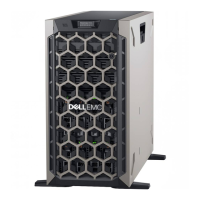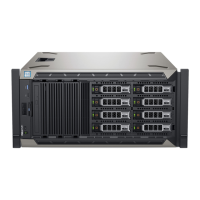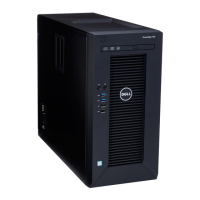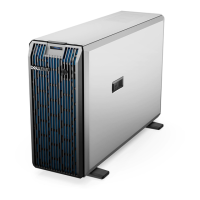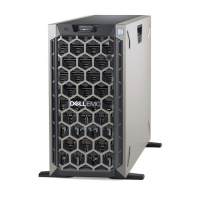



Do you have a question about the Dell PowerEdge T410 and is the answer not in the manual?
Learn how to access system setup and other features during startup.
Identify and understand the components and indicators on the system's front panel.
Identify and understand the components and indicators on the system's back panel.
Understand the meaning of status messages displayed on the LCD panel.
Learn about system messages and their corrective actions.
Select the boot mode (BIOS or UEFI) for installing the operating system.
Step-by-step guide to enter the system setup utility.
Overview of available configuration options within the System Setup program.
Configure system and setup passwords for security.
List of essential tools required for installing system components.
Procedures for safely opening and closing the system chassis.
Instructions for installing and removing hard drives.
Guidelines and procedures for installing system memory modules.
Information on installing and removing expansion cards.
Procedures for installing and removing system power supplies.
Instructions for installing and removing system processors.
Guide for replacing the system battery.
Procedures for removing and installing the system board.
Essential safety precautions before troubleshooting system issues.
Steps to diagnose and resolve system startup problems.
Procedures for troubleshooting issues with USB devices.
Steps to diagnose and resolve system memory-related issues.
Guide to diagnose and resolve problems with system power supplies.
Steps to diagnose and resolve issues with hard drives.
Guide to diagnose and resolve issues related to system processors.
Introduction to using Dell diagnostics tools for system assessment.
Overview of the features and options in embedded system diagnostics.
Step-by-step instructions for running embedded system diagnostics.
How to select specific devices and options for custom diagnostic tests.
Explanation of system board jumper settings and their functions.
Identification and description of system board connectors.
Procedure to disable system password using the jumper.
Information on how to contact Dell support for assistance.
Learn how to access system setup and other features during startup.
Identify and understand the components and indicators on the system's front panel.
Identify and understand the components and indicators on the system's back panel.
Understand the meaning of status messages displayed on the LCD panel.
Learn about system messages and their corrective actions.
Select the boot mode (BIOS or UEFI) for installing the operating system.
Step-by-step guide to enter the system setup utility.
Overview of available configuration options within the System Setup program.
Configure system and setup passwords for security.
List of essential tools required for installing system components.
Procedures for safely opening and closing the system chassis.
Instructions for installing and removing hard drives.
Guidelines and procedures for installing system memory modules.
Information on installing and removing expansion cards.
Procedures for installing and removing system power supplies.
Instructions for installing and removing system processors.
Guide for replacing the system battery.
Procedures for removing and installing the system board.
Essential safety precautions before troubleshooting system issues.
Steps to diagnose and resolve system startup problems.
Procedures for troubleshooting issues with USB devices.
Steps to diagnose and resolve system memory-related issues.
Guide to diagnose and resolve problems with system power supplies.
Steps to diagnose and resolve issues with hard drives.
Guide to diagnose and resolve issues related to system processors.
Introduction to using Dell diagnostics tools for system assessment.
Overview of the features and options in embedded system diagnostics.
Step-by-step instructions for running embedded system diagnostics.
How to select specific devices and options for custom diagnostic tests.
Explanation of system board jumper settings and their functions.
Identification and description of system board connectors.
Procedure to disable system password using the jumper.
Information on how to contact Dell support for assistance.
| Tcase | 77.6 °C |
|---|---|
| Bus type | QPI |
| Stepping | B1 |
| FSB Parity | No |
| Processor code | SLBV4 |
| Processor cache | 12 MB |
| Processor cores | 4 |
| Processor model | E5620 |
| System bus rate | 5.86 GT/s |
| Processor series | Intel Xeon 5600 Series |
| Processor socket | Socket B (LGA 1366) |
| Processor threads | 8 |
| Processor codename | Westmere EP |
| Motherboard chipset | Intel® 5500 |
| Number of QPI links | 2 |
| Processor frequency | 2.4 GHz |
| Processor cache type | Smart Cache |
| Processor lithography | 32 nm |
| Processor manufacturer | Intel |
| Processor package size | 42.5 X 45 mm |
| Processor front side bus | - MHz |
| Processor boost frequency | 2.66 GHz |
| Processor operating modes | 64-bit |
| ECC supported by processor | Yes |
| Supported instruction sets | SSE4.2 |
| Thermal Design Power (TDP) | 80 W |
| Number of processors installed | 1 |
| CPU multiplier (bus/core ratio) | 18 |
| Physical Address Extension (PAE) | 40 bit |
| Memory types supported by processor | DDR3 800/1066 |
| Memory channels supported by processor | Triple |
| Memory clock speeds supported by processor | 800, 1066 MHz |
| Memory bandwidth supported by processor (max) | 25.6 GB/s |
| Maximum internal memory supported by processor | 288 GB |
| HDD size | 3.5 \ |
| Optical drive type | DVD-RW |
| Total storage capacity | 250 GB |
| Maximum storage capacity | 12 TB |
| Number of HDDs supported | 6 |
| Memory slots | 8x DIMM |
| Internal memory | 4 GB |
| Memory clock speed | 1066 MHz |
| Internal memory type | DDR3-SDRAM |
| Maximum internal memory | 16 GB |
| Maximum graphics card memory | 8 MB |
| Graphics card | G200eW |
| Dimensions (W x D x H) (imperial) | 8.58 x 24.28 x 17.52 \ |
| Networking features | Gigabit Ethernet |
| PS/2 ports quantity | 0 |
| USB 2.0 ports quantity | USB 2.0 ports have a data transmission speed of 480 Mbps, and are backwards compatible with USB 1.1 ports. You can connect all kinds of peripheral devices to them. |
| Number of power supply units | - |
| Compatible operating systems | Microsoft SQL Server 2008 R2/Windows Small Business Server 2008/Essential Business Server 2008/Server 2008 SP2, x86/x64/Server 2008 R2/HPC Server 2008; Novell SUSE Linux Enterprise Server; Red Hat Enterprise Linux. |
| Chassis type | Tower |
| Processor ARK ID | 47925 |
| Intel® Turbo Boost Technology | 1.0 |
| Depth | 616.8 mm |
|---|---|
| Width | 217.9 mm |
| Height | 444.9 mm |


